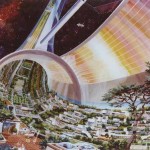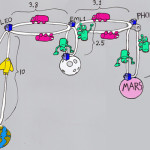Mission vs Colony vs Settlement
There is often bandied about the idea of colonizing space, or Mars. But personally, I would rather “settle” the Moon, then Mars. In my post, Mission, Colony, Settlement: What’s the difference? I identify definitions, as well as differences between these three concepts. Perhaps the most important is that a Settlement is a home, a place to be free to develop your own way of life … with or without others. Though having others around does add a sense of community. And provide a sense of security through greater numbers.
But creating settlements on Earth was generally much easier than it will be to create settlements on the Moon, Mars, or in free space. On Earth we have the benefit of comfortable gravity, breathable air, dirt to grow food in, and generally available water to feed those plants. And … if we are clever, we can enlist some fish and foul to produce additional meat sources for our consumption.
Settlements in Space, on the Moon or Mars will require us to rethink the whole idea of what home is. And to a degree, some people in the country are already looking in this direction when it comes to self-sufficiency. Generating power, growing food, recycling air, water, and wastes is becoming more interesting as survivalists, preppers, and entrepreneurs are looking at hydroponics and aquaponics as ways to grow a business.
Sadly, these settlements will be on the frontier; the frontier is a hard, dirty, work-a-day, struggle to survive. Anyone who tries to tell you that the sterile, technology-ridden, space station is a good example of how a settlement might develop is lying. The frontier — any frontier, is deadly.
The Biome
 We have grown to understand our Earth as a Biosphere, the first, teeming with life, and a circle of life in which a food-chain exists to assure that nothing is wasted from the tiniest bacterium to the greatest whale in the ocean. While technology has assisted us in developing homes, towns, cities, and even nations, it is becoming increasingly clear that the technology of our cities is compromising the very biosphere in which we live and breathe. But to understand the greater biosphere, perhaps we can embrace a smaller version of it, the Biome.
We have grown to understand our Earth as a Biosphere, the first, teeming with life, and a circle of life in which a food-chain exists to assure that nothing is wasted from the tiniest bacterium to the greatest whale in the ocean. While technology has assisted us in developing homes, towns, cities, and even nations, it is becoming increasingly clear that the technology of our cities is compromising the very biosphere in which we live and breathe. But to understand the greater biosphere, perhaps we can embrace a smaller version of it, the Biome.
Many who think of a biosphere recall the effort of Biosphere 2 many years ago. But what I refer to as a Biome is first, much smaller. In point of fact, a Biome is designed around a single human being being the key recipient. With that in mind, it seems much easier to gradually scale such an operation up for more humans to benefit. My project, the Tiny Home Technology Demonstrator is such a design for a rolling Biome. When completed, the THTD will contain a fish pond, aquaponic garden, composting toilet, 5-stage water filtration, and even a solar power plant. The THTD is a template for settling space, and is nearing completion.
There are several components to be included in our Biome, to assure our continued survival:
- Air Production
- Food Production
- Water Purification
- Waste Processing — without wasting anything
- Power Production
- Construction Materials
- Rocket Fuel
Of course, in space, on the Moon, and on Mars we will need something to contain our biome within – a habitat within which we will live, and work, and grow. While here, I can easily develop my THTD, but there … well, we’ll need more than a tin-can to survive longer than a few months. So I will break down the habitat and it’s biome below.
Habitat Construction
A reasonable habitat must be solid, protect from radiation and the vacuum of space, and most importantly it must be expandable. No tin-can buried in dirt can do that.
Habitat Layout
The habitat will be our world, providing all of the key components necessary for our survival. Not the least of which is a shirtsleeve environment in which to grow our food, and develop further so we can expand deeper into space. So, the layout must factor in how much space is required for each component of our Biome: i.e. fish, foul, insects, plants, and of course us.
It must be compact, and efficient, yet with enough elbow room to allow a modicum of privacy. In this process, we will develop a methodology to be applied to any rock in the solar system, small or large. Dig a hole, seal it, move in, and proliferate!
Economics of Settlement
From funding the first team to paying the bills as we get going, it will be challenging to finance a
settlement. The companies that attempted to fund the settlement of the American colonies were a daisy chain of investment groups that each went belly up trying to generate a return on investment in the fledgling colonies, with a few notable exceptions. Todays economic environment, while very similar to that of the 1600’s, has the benefit of orders of magnitude larger numbers of people who may be interested in plunking down a ten-spot through social-media-funding to be a part of opening the frontier to human settlement.
It is important to understand that the economics of space settlement will be a very public thing. Government funding may be involved, but in a far smaller capacity that it has been to date. The tasks to be completed for permanent human settlement are far beyond the funding capacity of even the most generous government organizations.
Infrastructure for Growth
And finally, using the foundation of the habitat to seed communities that will build the infrastructure to distribute humanity to the solar system, and later the stars.



